#warsaw was fantastic
Explore tagged Tumblr posts
Text
Trending on 4th place 👀
Those new outfits really made us going crazy

Laughing at the fact that only Kris is trending
39 notes
·
View notes
Text
Walk with me, friends. Theatre des Vampires production of Grotowski's adaptation of Wyspiański's Akropolis
#Post for my 5 mutuals who care about both Vampire Show and midcentury Polish experimental theater#Gd it would be SO fucked up. It would be SO fantastic#Imagining a Polish vampire theater coven. They're based in Łódź. Weirdly for historical reasons not for My Autism reasons#That's just where the main traveling theater troupe decamped to after 1945#Then a lot of them split up into troupes either in Warsaw or around the former German territories in Silesia
4 notes
·
View notes
Text
hello everyone!! happy feburary and welcome to my “jellicle ball appreciation posts” series where i discuss my favourite part of the whole musical! specifically about the 1998 version because, oh boy, my love for this recording of a 10 minute dance break knows no bounds. refer to this video for the names of the different sections of the jellicle ball aaaand let’s begin!!!
jellicle ball appreciation posts :
perfect timing
anyone who’s danced before knows that doing all those moves, especially for more fast paced dances, takes exceptional strength and control to execute them well. in order to have that control, and of course because moving your limbs and getting from one place to another takes time, you sometimes have to sacrifice one extra second to perform the last move before moving on to the next one. for example, watch bombalurina after “arabesque” as she’s getting into place for “warsaw (ecstasy)”. unlike most others, she raises her arms a little late because she has to run into position from the back. although it’s a pretty minor issue, when this happens your performance can appear delayed and you often end up rushing the following move.
so one of the most satisfying things for me to watch as an ex-dancer (besides straight up satisfying dancing which we will talk about in the future) is someone hitting their mark on a dance move perfectly or even a little early. one example of this is, during “slow paws” jemima’s arm movements are completely in time with the music, and she raises her arms perfectly on cue during “arabesque”.
but absolutely nothing scratches this itch more than watching tumblebrutus, or fergus logan, dance. seriously, who gave this man the right to be THAT graceful???? i cannot even express how euphoric it is to watch him during the jellicle ball and i sometimes open the film just to watch him. i genuinely love the “boys ballet” section so much because of him and fergus logan has become one of my favourite dancers in the show, or ever, if not my favourite. and for the same reason (but not the only one) tumblebrutus is also one of my top favourite cats.

when tumble and misto stand up and do their windmill thing during “spikey”, fergus is completely focused on dancing. you can see it on his face. as a result, tumble is eager and ready to do the next move, and it shows because he hits the mark perfectly and my gosh, i hope you guys know how much i wish i could absorb that moment into my soul. and the way he “windmills” is just like, he swings his arms so freely and effortlessly and elegantly and so in time with the music, it’s just so pleasing to watch. compared to jacob brent, who’s more focused on staying in character, which i absolutely don’t blame him for since he has a very important role, but as a result he ends up windmilling a little bit late and rushes the next one. mistoffelees’ dancing has more of his flavour and spark, but tumblebrutus’s movements are just so freaking refined and graceful and everything, and i highly doubt this will be the last time i talk about fergus logan in these posts.
as much as i love these “perfect timing” moments though, i also happen to care a lot about the moments like i mentioned in the first paragraph, because there’s something beautiful about seeing the humanity behind a piece of art, especially in the case of dance and professional dancers. it shows that no matter how fantastical this world is or how impressive the cats’ feats are, these are still actors, human beings, and they make mistakes on stage sometimes too and that’s ok. it just shows how much effort is needed to pull this off and put on a successful show. cats the musical is one of the only pieces of media that i know of, where it can break the immersion in a serious manner (or even unintentionally) and have it make the experience even more magical.

part 2~~
21 notes
·
View notes
Text





idkhow: Arrived in Warsaw. All fires both literal and figurative were extinguished. Then Warsaw lit a fire of their own! An amazing start to what will surely be a fantastic run of shows in Europe!
-📸 @jacobspreng & @anbursztynphotography
55 notes
·
View notes
Text
paintings* round 1 poll 19


Illustration for St. Nicholas by Mary Mapes Dodge by Władysław T. Benda, c. 1904:
[no propaganda has been submitted]
Insanalia by Bartosz Stępiński, 2024:
propaganda: Są w tej chwili wystawione w Muzeum Sztuki Fantastycznej w Warszawie i polecam zobaczyć na żywo jak ktoś ma okazję, bo te detale i tekstura are wonderful [currently it is on display in the Museum of Fantastical Art in Warsaw and I recommend going to see it live if you have the chance, because the details and the texture are wonderful]
42 notes
·
View notes
Text
Мрачно-фантастические работы выдающегося польского художника Здзислава Бексиньского. (Zdzisław Beksiński)
Darkly fantastic works by the outstanding Polish artist Zdzislaw Beksinski.

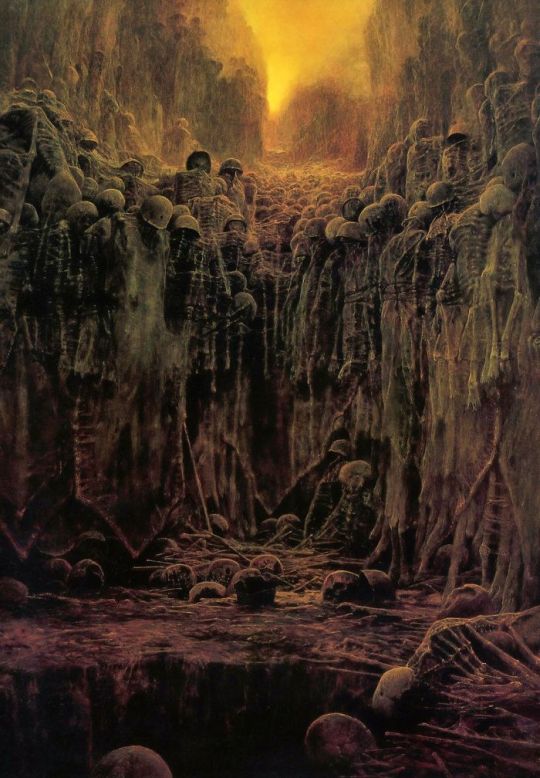

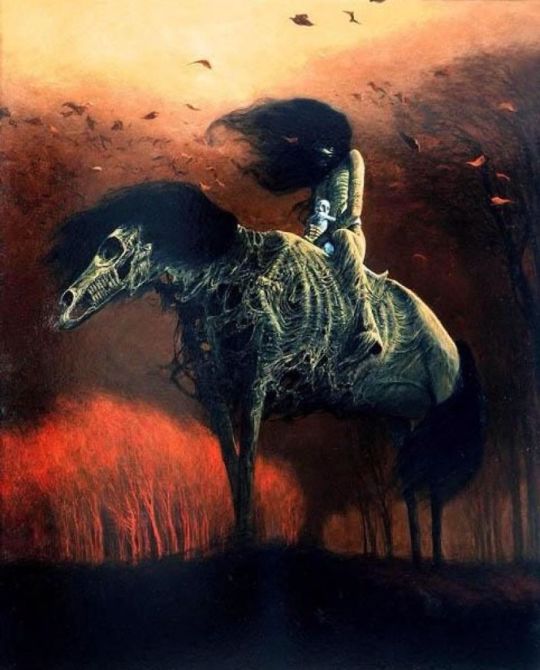
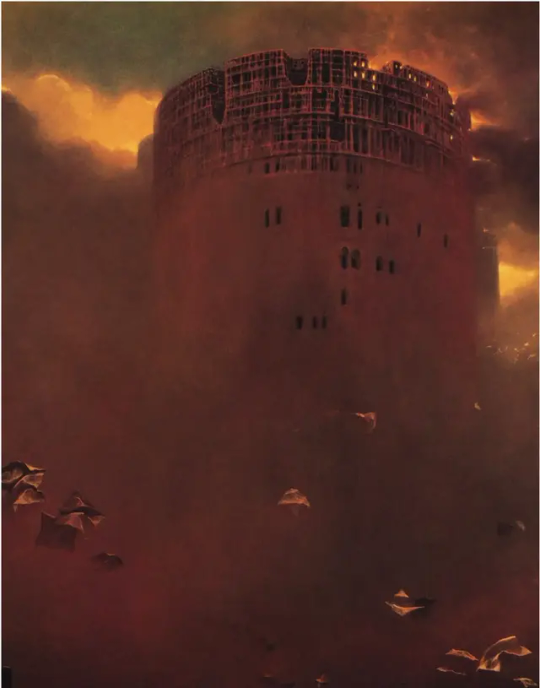


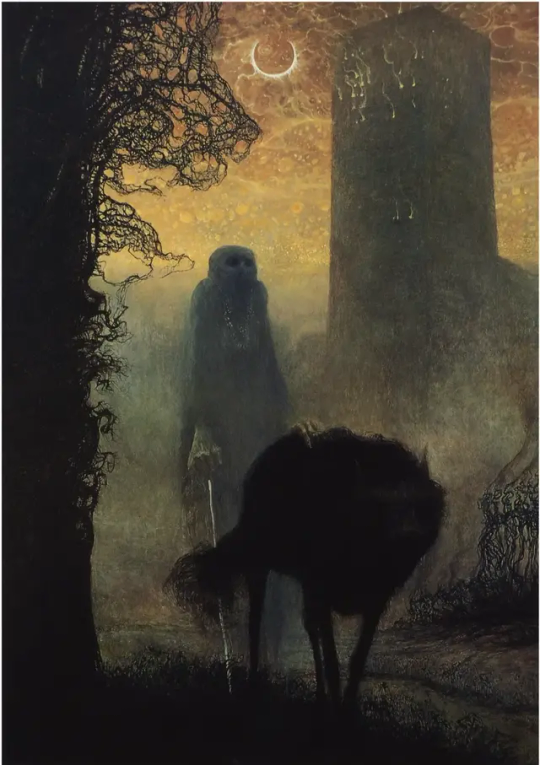
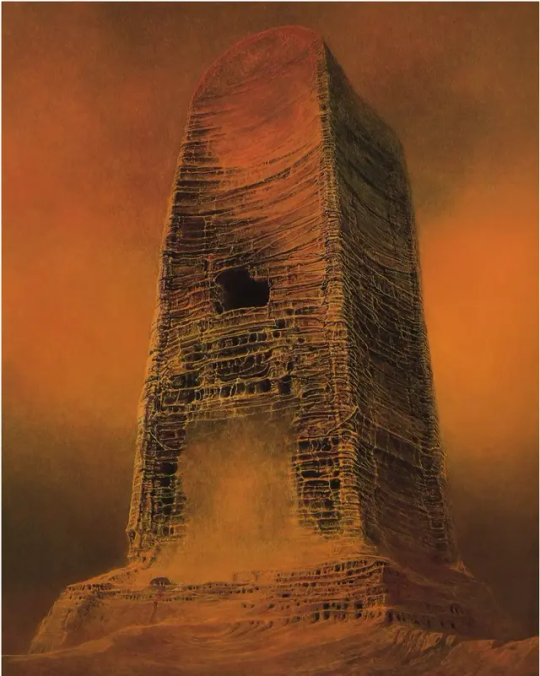
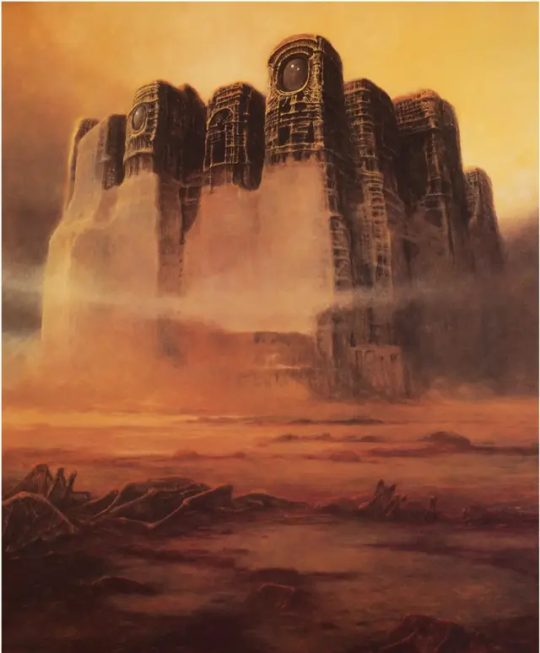

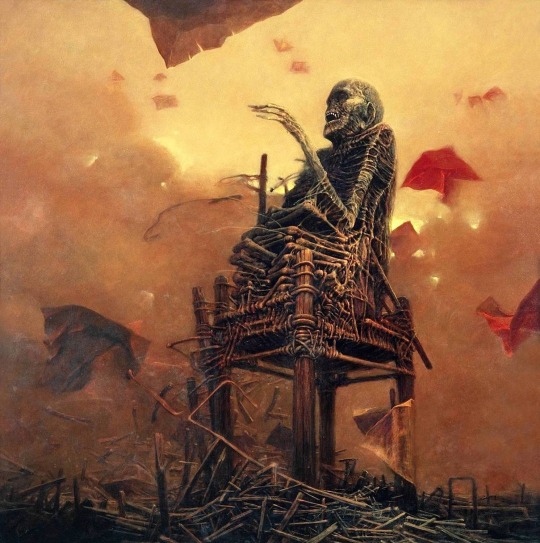

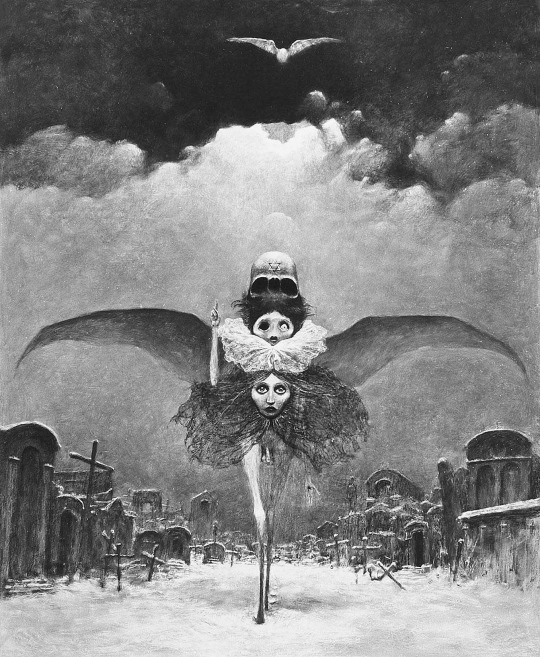
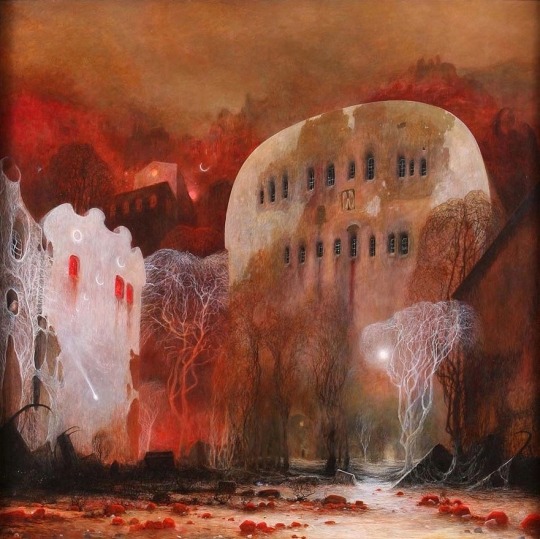
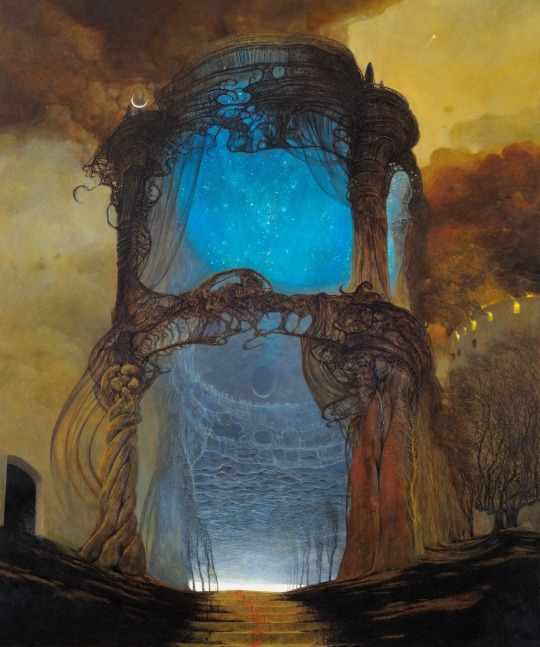

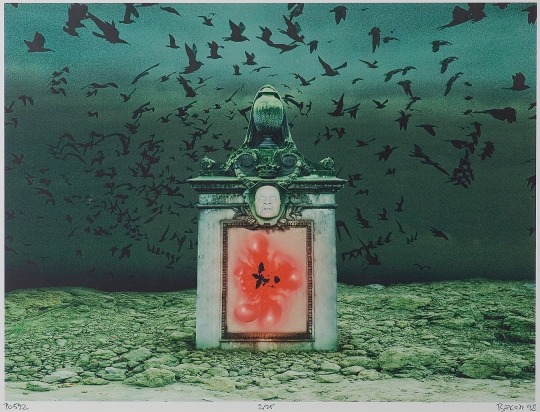







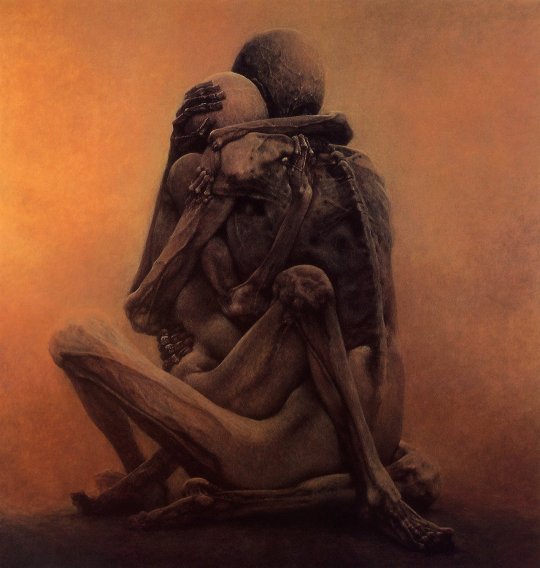
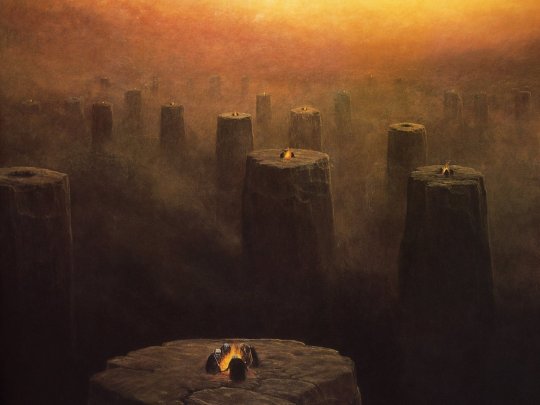

Очарование мрачных картин польского художника второй половины ХХ века Здзислава Бексиньского представляет собой нетипичный вариант сюрреализма с ярко выраженной апокалиптичной темати��ой. Бексиньский стал известен своим уникальным и мрачно-фантастическим стилем. Его картины в основном созданы с использованием масляных красок на оргалитовых панелях, которые он подготавливал сам. Произведения Бексиньского, насыщенные темными тонами и пугающими образами, привлекают внимание зрителей своей глубиной и оригинальностью.
В работах Бексиньского часто присутствуют непонятные и загадочные персонажи, создающие атмосферу невероятного и потустороннего. Абстракция и реализм переплетаются в его работах, придавая им особый очарование и таинственность. Художник исследовал темы смерти, разрушения и одиночества, передавая эти эмоции через каждый штрих кисти. Бексиньский умело сочетал мрачность с красотой, создавая удивительные образы, которые заставляют нас задуматься о смысле жизни и ее бренности. Однажды он сказал: «Важно то, что появляется в вашей душе, а не то, что видят ваши глаза».
Здзислав Бексиньский получил известность в Западной Европе, Японии и США. Он говорил, что он творит в одной из двух манер: барочной и готической. В первой преобладало содержание, а во второй – форма.Во время своего "фантастического" периода Бексиньский говорил: «Я хотел бы рисовать в такой манере, словно это сфотографированные сны».
Сам Бексиньский погиб в собственной варшавской квартире, где его обнаружили с семнадцатью колотыми ранами в феврале 2005 года. Виновным признали 19-летнего сына коменданта дома, в котором жил художник. Причиной нападения стал отказ Бексиньского дать денег в долг. Художник остается одним из самых влиятельных и инновационных представителей современного искусства, продолжая вдохновлять новое поколение художников своим неповторимым стилем и философией.
The charm of the dark paintings of the Polish artist of the second half of the twentieth century, Zdzislaw Beksinski, represents an atypical version of surrealism with a pronounced apocalyptic theme. Beksinski became known for his unique and darkly fantastic style. His paintings are mainly created using oil paints on hardboard panels, which he prepared himself. Beksiński's works, rich in dark tones and frightening images, attract the attention of viewers with their depth and originality.
Beksinski's works often feature incomprehensible and mysterious characters, creating an atmosphere of the incredible and otherworldly. Abstraction and realism are intertwined in his works, giving them a special charm and mystery. The artist explored themes of death, destruction and loneliness, conveying these emotions through every stroke of the brush. Beksinski skillfully combined darkness with beauty, creating amazing images that make us think about the meaning of life and its frailty. He once said: “It is what appears in your soul that matters, not what your eyes see.”
Zdzisław Beksiński gained fame in Western Europe, Japan and the USA. He said that he creates in one of two styles: baroque and gothic. In the first, content predominated, and in the second, form. During his “fantastic” period, Beksiński said: “I would like to paint in such a manner as if they were photographed dreams.”
Beksinski himself died in his Warsaw apartment, where he was found with seventeen stab wounds in February 2005. The 19-year-old son of the commandant of the house where the artist lived was found guilty. The reason for the attack was Beksinski's refusal to lend money. The artist remains one of the most influential and innovative representatives of contemporary art, continuing to inspire a new generation of artists with his unique style and philosophy.
Источник:/cameralabs.org/9929-polskij-khudozhnik-zdzislav-beksinskij, /pikuli.top/36534-zdzislav-beksinskij.html, artchive.ru/artists/11292~Zdzislav_Beksin'skij, /bigpicture.ru/uzhasayushhie-kartiny-polskogo-xudozhnika-ubitogo-pomeshhavshimisya-podrostkam/, /reactor.cc/post/1869160
#dark artist#Zdzisław Beksiński#surrealism#apocalyptic art#horrorcore#darkness#Gothic#horrorart#dark fantasy#darkfantasy art#живопись#картины#художник#Здзислав Бексиньский#сюрреализм#Постапокалиптика#фэнтези арт#темное искусство#готика#ужасы#кошмары#монстры
124 notes
·
View notes
Text




Sooooooo... I bought as much as I could, and it's Macavity's costume. Two versions of body, mostly by curiosity.
Boots are mostly of curiosity of how it is walking in dancing boots. And two posters from theatre, that simpler one thanks to an absolutely fantastic person who let us take a picture in her work place :) And Munkustrap's gloves, for fun.
Plan for now? Recreate missing parts, make copies and have a beautiful cosplay of Warsaw Macavity. And preserving that one. Later do copy of Chorzów Macavity, also as a cosplay.
Life is beautiful sometimes :)
18 notes
·
View notes
Note
wait babe do you have goth recs for meeeee 🖤🦇🕯
hi<3!! yes yes I do. Disclaimer that this is probably nothing novel but I'm giving it a shot.
The first goth music I ever listened to was not anglophone-- it was mostly Russian and Belarusian post-punk, like Molchat Doma and Утро. Highly recommend everything going on there, basically-- can't pick favourites for the former, but for the latter it's their song Дом. I also ADORE Manaam. Lipstick on the Glass is amazing, my favourite, but I never get tired of any of their music. Polish 80s and 90s shoegaze is in general excellent. I've been listening to some Кино also. Latin America also has some great artists-- I'm particularly fond of Píldora Letal, especially the song Cicatrices, which i'm downright obsessed with, but all of their work is so so good. Another group I'm fond of is Vacios Cuerpos.
As for anglophone, I saw you're listening to Bauhaus which. that's perfect-- my top three are She's in Parties, All We Ever Wanted was Everything, and The Passion of Lovers. Also heavily recommend The Cure, of course; they took me a while to get into for some reason but once I did, well. I love the album Disintegration most right now; apart from that I'm deeply fond of their songs One Hundred Years, Burn, and Kyoto Song atm. Their newest album is also excellent. Also I'm not going to argue about whether Depeche Mode are goth or not-- a friend of mine and I spent a year and a half arguing about this on-and-off-- they are to me because I want them to be. I recommend everything they've ever done, favourite albums being Music for the Masses, Violator, and Black Celebration. A more contemporary goth group that I love is Lebanon Hanover, they're quite good. Joy Division is another classic, of course-- they're not my absolute favourite, but I do like them: She's Lost Control, Warsaw, Disorder, Love Will Tear Us Apart, Shadowplay, Atmosphere.... it's worth looking at for sure. Siouxsie and the Banshees (though my favourite song of Siouxsie's is the one she made for Hannibal's finale, Love Crime), Cocteau Twins (Blood Bitch is fantastic), and if you want to get sort of unorthodox, the soundtrack for the the film Only Lovers Left Alive.
That's my summary for a starting point, I'll also go ahead and drop my goth playlist-- it's not 100% music that falls into the strict definition of goth, but it's largely that + what is goth To Me, Let Me Live:
I hope you enjoy<3
9 notes
·
View notes
Text
Just remembered that there is a Polish version of the Metro universe and it's really funny because like, if you have ever heard anything about the original series you know that it takes place in the Moscow metro, which is gigantic and pretty fucking complicated

Every time I'm rereading these books and the name of the station pops up I search for it on the map to place it somewhere and I can never remember which stations are supposed to be next to each other, even after a dozen readthroughs. It's a fantastic, complex setting which gives the author so many opportunities to put cool shit in this world.
Now, there is a book series in Poland where the concept is the same as in Glukhovsky's books, but it takes place in the Warsaw metro. And the contrast between the two is so funny.
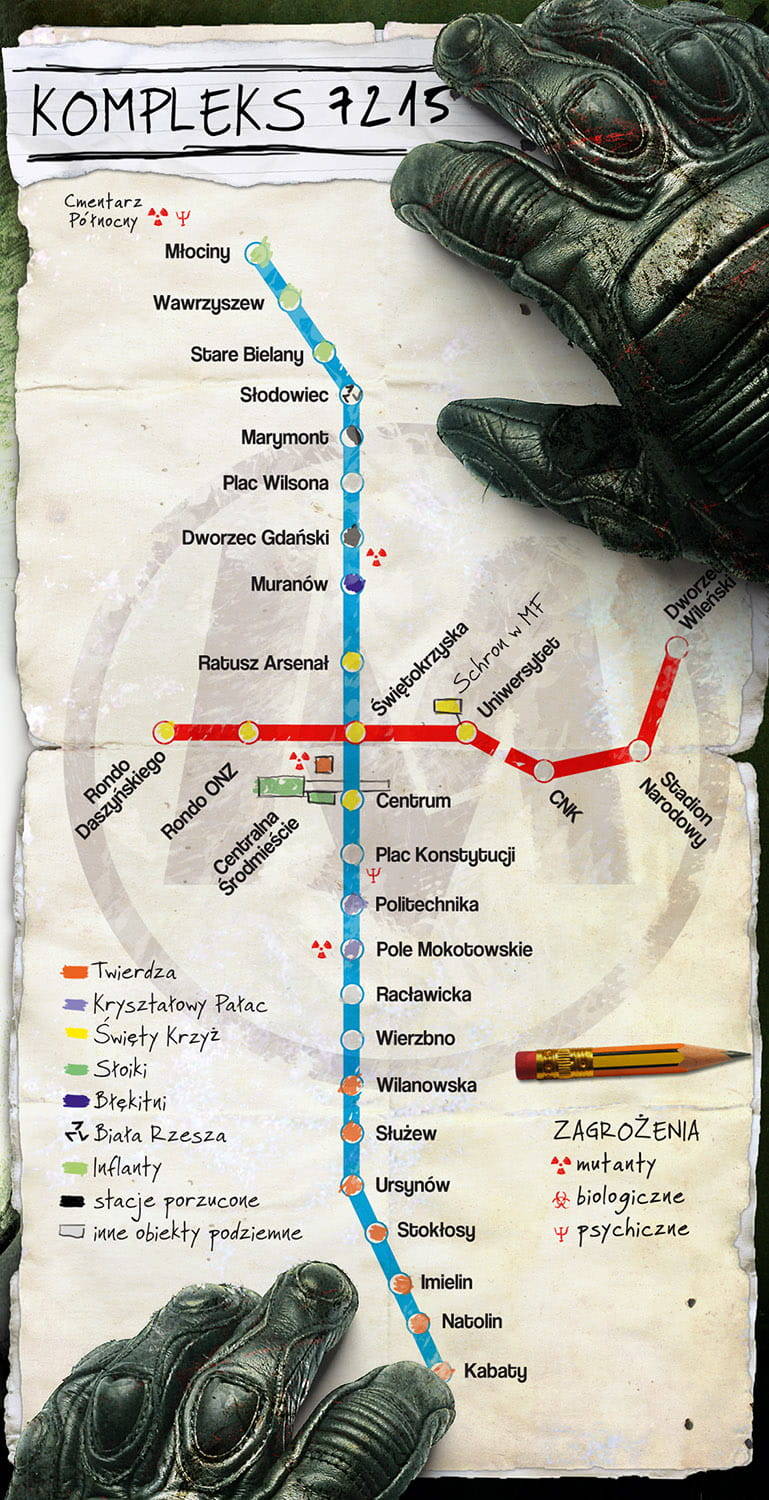
It's so tinyyyy. I loved these books as a kid and I read them years before the original series, but compared to the Moscow metro this is just like a younger sibling copying the older one in an adorable way
#also i will never forgive them for not doing anything with marymont since it already looks like a YA postapocalyptic setting#metro#metro 2033
52 notes
·
View notes
Text
games games'd recently

Solar Ash: the second game by the people who made Hyper Light Drifter. My feelings about it largely align with the reviews: gorgeous aesthetic if not quite as personally a vibe as HLD, the skating flows really nicely, the 'track down all the collectable things' structure was a little frustrating at times but I got used to it, the Shadow of the Colossus-like boss battles were a lot of fun when they worked.
It's a game about a decaying world full of people trapped in cycles of facing their last, worst moments. Most of the people you meet are some kind of animal people - cat people, fungus people, snail space imperialists - and the tone varies between darkly comedic and Meditating Severely On Death. The tone often swings a little pulpy.
So, ultimately - spoilers! - it turns out to be a time loop (something they pretty heavily foreshadow). Your player character Rei is one half of a split being who, after failing to save her world, has been resetting time and time again. The character 'Echo' who you encounter after every boss fight, with a white theme in contrast to your character's black motifs, is the other half of you - the half that isn't convinced to keep trying over and over again to save your planet and is pretty mad at Rei for prolonging this whole miserable existence.
In the true ending finale sequence, Rei finally concedes and turns into a big monster, and you play as Echo (who conveniently controls the exact same as Rei) to pull out the big spikes impaling her, metaphorically allowing her to reconcile with you and allow the world to move on with the other characters .
So like, big old trauma flashback metaphor I guess? The character's inner world is reflected in a big expansive scifi.
The thing that intrigues me most about this game is the tech art. For example, take the cyan goop you surf along in various levels. It looks like it's made of metaballs, and I kind of wonder if they are doing some clever stuff with meshing, or if they're rendering with signed distance fields, or what... in any case, it leads to some very cool level design where you can skate over all surfaces of the blobby space matter, and there is no consistent 'down' direction.
I went looking for how they did this and I ended up finding a half-hour talk from the lead technical artist, which doesn't really address the cyan goop, but does talk about integrating Houdini procedural simulations into the game using Unreal...
youtube
He talks mostly about the process of authoring the game's 'islands' (using a procedural editor tool that runs Houdini to generate the geometry), but does casually mention the clouds becoming 'really cool SDF clouds' in game, so I guess I called it! Really cool that that can run real time without being too expensive. I am definitely curious about how they handled raymarching so many metaballs (assuming they used raymarching, but that is the standard way to render SDFs).
It's kind of crazy that Heart Machine could go from a Game Maker game (even one with fantastic art direction) to a game as ambitious as this one. In practice though... running all over the bosses is cool but with the amount of camera hinting (necessary at the speed you're moving) it kind of feels like a series of QTEs, just figuring out where the next node is and trying to avoid jumping in the black goop, and if you screw up, you have to try again from the start. They're really cool sequences, but from a gameplay perspective, more like a rhythm game than anything.
This game didn't quite hit the same level of 'wow vibes' of HLD for me - I liked the atmosphere of HLD, the quiet and haunted world, the Nausicaa-like monsters. But I definitely enjoyed my time with it, and it's crazy inspiring on a tech art level.

The Thaumaturge: This is the latest game from 11 Bit Studios, of Frostpunk and This War of Mine fame. It's a fascinating concept: an RPG set in Warsaw at the turn of the 20th century, a world of boiling-over social tensions, in which you play essentially a wizard who summons invisible demons salutors to reveal secrets and manipulate people. Your father (also a wizard, you hated him) died mysteriously and now you're back at the family home to try to investigate.
I haven't finished this game yet (nowhere near, it's a big game), but I wanted to briefly comment!
In the first ten minutes of this game, you go to meet Rasputin. From that point I was already pretty much sold.
After sorting out some peasant-y business in what is essentially the tutorial area, you travel to Warsaw where the bulk of the game takes place, currently ruled by the Russian empire. Pretty much as soon as you get off the train, you run into Tsar Nicholas giving a speech, and get caught up in a tense standoff between the Russian cops and Polish workers. I ended up in prison lmao
This is the type of RPG that does have a combat system, and finds some... kinda awkward reasons to get Wiktor Szulski into fights now and again, but it's a pretty intriguing design oriented mostly around applying and exploiting status effects. But really, I'm here for the story, and the period setting. Although 11Bit are not a Polish studio, the game has the option of full voice acting in Polish, which is really sick - apparently they put some effort into giving it period language as well. And even though this is an occult story about wizard business, there's clearly a huge amount of love for the historical setting - there's a bunch of mini sidequests that just take you to look at landmarks and get a little bit of xp from it.
Wiktor is a fun protagonist to inhabit, and the game encourages you towards spicier dialogue options with its system of Flaws - essentially, each salutor is associated with a point of characterisation, such as pride, and if you feed that flaw by picking prideful dialogue options when they're offered, that will apparently make your salutor more powerful. It is certainly reminiscent of Disco Elysium's design with the thoughts as characters, but it's got enough of its own flavour to not feel derivative.
I will surely have much more to say about The Thaumaturge as I progress through it, but honestly, just wanted to shine a light on this game because it's fascinating. This kind of RPG doesn't come along often enough.

Neon White: Only just started on this one. It's exactly what everyone says: an addicting game designed to ease you into speedrunning. I have two friends on Steam who have played it and both of their times are very tight and several seconds faster than what I'm able to do lol.
Everyone also says the plot is a bit ehh and well... they're right. Strangely the tone reminded me most of all of the anime Mahou Shoujo Magical Destroyers: oddly casual, and despite the weebcore vibes, the character archetypes are more American - bubbly psycho girl, femme fatale, frat bro. It's very much aiming for humour, and generally it's not terrible, but the hit rate there is kinda mixed. I'm actually a bit surprised by it - given the aesthetic with the hannya masks everywhere, I was kinda expecting something way more chuuni, but it's quite laid back so far.
But none of that matters really because it's a speedrunning game, it's not about the story! The controls are tight as hell, the levels are elegantly designed to steer you towards picking up on shortcuts with a compelling learning curve, and restarting is incredibly easy. So far I've grabbed Ace medals on every level I've played, but there's a huge amount of room for improvement still. Definitely reminiscent of doing time trials in Mirror's Edge back in the day. Definitely gonna play this more.
13 notes
·
View notes
Text
THE LURE (2015) a fishy blog
SHORT-FILM SKIN DEEP and THE WATER PHOENIX (1233)

I have always been fascinated by mermaids, and carrying the burden of 76 years deambulating on this planet, this fascination has only grown stronger. Over the years, many films have explored these mythical creatures, proving that I am not alone in my fixation. These movies often create breathtaking visual underwater worlds. As an avid swimmer, I sometimes wish, like in the movie WATERWORLD, that I had gills behind my ears to breathe underwater.

In my quest to find a film that takes this fantastical world to another level of creativity, you will find the movie I selected at the bottom of this blog truly unique. It is a mixture of a musical horror show. I am continually amazed by the human imagination. Let’s thank our creator for small favors that go a long way.

On the last night of summer in a sleepy seaside town, an insecure young woman finally reveals to her crush exactly how she feels - and what she is.
Skin Deep (Short 2023) - IMDb 5'7
youtube
1233-1link: https://youtu.be/TVEOwcI95Ms reblog source junkyarddemento Sep 4
Killer mermaids? Maybe, but regardless of what exactly the monsters are in SKIN DEEP, this entertaining horror short feels like a fun modern day folklore about the thing that come out of the ocean to lure men!

When an imprisoned mermaid is betrayed by her caretaker, she must find a way to escape the aquarium alone.
The Water Phoenix (Short 2017) - IMDb 6'7
youtube
1233-2link: https://youtu.be/zmBXjZ_7IQQ
Bola Ogun Creates Black Mermaid Film “The Water Phoenix” (theblerdgurl.com)

Since 2017, The Water Phoenix has been recognized at numerous festivals. The film is very well produced and features impressive effects from such a small budget short. You believe Ogun’s performance as Anya, (I have no idea how she held her breath like that) and it’s not lost on me that her “lover” is a man who wishes to express his love by possessing or owning her.

The Lure is a 2015 Polish musical horror film directed by Agnieszka Smoczyńska.

The film tells the story of two sirens who emerge from the waters and perform in a nightclub. One falls in love with a man, and gives up her tail, but loses her voice in the process. The story is a reworking of the 1837 fairy tale "The Little Mermaid" by Hans Christian Andersen, with inspiration from Smoczyńska's experiences.
The Lure (2015 film) - Wikipedia
The Lure (2015) - IMDb 6'3
1233-3link https://ok.ru/video/4480939461309
notes
The 20 Best Mermaid Movies Of All Time, Ranked (ranker.com)
The 10 best mermaid movies ever, ranked | Polygon
31 Best Mermaid Movies | POPSUGAR Entertainment
Movies With Mermaids (imdb.com)
6 notes
·
View notes
Text




Full-lenght feature for family audience, combining animation and live-action. The project in development since 2012, completed in 2024. Inspired by classic comic books from the 80′, created by Tadeusz Baranowski. The movie is produced by Human Film (formerly Human Ark) in coproduction with PFX, Telewizja Polska SA, dayhey, Mazovia Warsaw Film Commission.
Writer & Director: Wojtek Wawszczyk Art Director: Tomasz Lew Leśniak Production: Human Film Co-production: PFX, Telewizja Polska SA, dayhey, Mazovia Warsaw Film Commission
Our part in making the film Agata & Tomek Karelus: Concept art, key frames, surfacing, mattepainting
It's been quite a ride! Almost a year of working on concept art, textures, and underpainting, and we were just a small part of a huge team of incredibly talented people who poured their hearts and souls into this film. We grew up reading Tadeusz Baranowski's comics. I never imagined that now, as parents of a child the same age as we were back then, we would have the opportunity to work on a project with the heroes of our childhood. I think it turned out fantastically! But none of this would have been possible without this amazing team. We're truly grateful!
3 notes
·
View notes
Text
Back in 2016, I self harmed quite severely and had to go to hospital. Thankfully, I survived, and I’m still here.
But following that crazy incident, my self esteem was at an all time low. I just felt so unachieved, and I doubted my credibility as a writer. What made it worse was that my elder brother got married, and he had all of these fantastic friends, and he was a successful musician – so I felt like a lesser sibling.
And my girlfriend at the time kept comparing me to him in a negative way, and not just him but my other siblings too. So all in all I was pretty mucked up in a psychological way.
The NHS assigned me to a therapist so I could speak about the self harm incident. And he was really fantastic – a very nice, engaging man. And he asked lots of questions that tucked in to the issue and he seemed to guess the dilemma without really knowing me. It helped to speak to him.
Then in the summer, I was in Poland and my then girlfriend said something that ruptured my self esteem all over again. I nearly jumped out of a window, ten storeys up in a Warsaw hotel. And, thank God I didn’t – as I wouldn’t have survived that fall.
Anyway, when I got back to Scotland, I tried to get in touch with the therapist again – because he had invited me to come back for a final meeting about various issues.
But the man had left the practise. He had moved on and worked somewhere else now.
I still really needed to speak to somebody, so I spoke with this chap on the phone, who I thought was a therapist as well. In a really desperate, frenzied mood, I went in and met this new man. And I splurged out all of my issues to him. As I was speaking, I realised that he wasn’t a therapist in a specialised sense: he was a regular GP. Not that he wasn’t a pleasant man as well – he was – but as I was relaying my problems in a manic manner, it was obvious he didn’t have the skills to help me out.
It was really embarrassing. And after I left, I just felt totally lost. Like nobody could help me. ‘I’m the only one who can help me out,’ I thought. So it was as if after all that had happened
I literally couldn’t even turn to the NHS for aid.
I needed to come up with a solution for the whole thing. What I wanted most of all was to become a published prose writer. So I started writing short fiction intensely. I reckoned, ‘I have to get some fiction published – there is no other route’. I wrote stories and sent them out in the latter half of 2016. And they were routinely rejected by the publishers. And each rejection was a further stab and did nothing to ease my issues.
But I just kept trying. And in 2017 I wrote a story based on a man who attacked me when I was in my teens. It was a fictional story, with the premise being his assault of me.
That was in January when I wrote it, when I was in Prague. And in March 2017 it was published. I’d done it. Somebody liked it enough to publish my fiction. I knew that writing was what was going to keep me alive. And, though life is often very hard, it’s worth living for the mini achievements you put the work into.
3 notes
·
View notes
Text
Ukrainian children went to camp in England
A scout leader from Ukraine has said children will be able to spend a week “far from danger” during the Essex International Rally, BBC reports.
Twenty-one teenagers from the war-torn country are among more than 4,500 children and youngsters travelling to the event at Roxwell, near Chelmsford, which runs until Saturday.
Antonina Prudko said they had to collect their visas in Warsaw, Poland, and then travelled by bus, train and plane to Essex. She told the BBC:
We are here and really happy to be here. We managed to collect children from different Ukrainian cities and get here, far from danger. They feel safer here and have a great time meeting new friends and doing different activities.
The first Essex County Gathering was held at Prairie Park in Southend-on-Sea in 1927 and was attended by Robert Baden-Powell, the founder of the Scouting movement. The event has been held every four years since then and in 1949 it was opened to international scouts for the first time.
Nine-year-old Eva was part of a group that travelled from Ukraine to attend this year’s convention. She said:
I think this is really cool, it’s the best idea.
This year’s event attracted participants from over 40 countries and was organised by 1,500 adult volunteers.
Rally leader Paul Walker said there was a “fantastically magical atmosphere” at the event. He also added:
They’re getting stuck in to being themselves for a week in a field and away from mums and dads – and having a great time. They’re going to have memories for life here.
Read more HERE

#world news#news#world politics#europe#european news#uk politics#uk news#england#london#united kingdom#ukrainian#war in ukraine#news of ukraine#russia#ukraine#ukraine war#ukraine conflict#ukraine news#ukraine russia conflict#ukraine russia news#russo ukrainian war#war#russia ukraine war#russia ukraine crisis#russia ukraine conflict#russia ukraine today#camp camp#camping
2 notes
·
View notes
Text
paintings round 2 poll 10


tap to view full images
Insanalia by Bartosz Stępiński, 2024:
propaganda: Są w tej chwili wystawione w Muzeum Sztuki Fantastycznej w Warszawie i polecam zobaczyć na żywo jak ktoś ma okazję, bo te detale i tekstura are wonderful [currently it is on display in the Museum of Fantastical Art in Warsaw and I recommend going to see it live if you have the chance, because the details and the texture are wonderful]
Death and conflagration, central section of the triptych “Disaster” by Adam Chmielowski, c. 1870:
[no propaganda has been submitted]
32 notes
·
View notes
Text
1989: thought dump
I've heard about 1989 the musical, but it's playing in theatres far from Warsaw and I've been frankly busy this past year with funerals and health crises. Now I've finally seen a live proshot (whee, guess who recorded it too) and this is nowhere near a review, these are absolutely random thoughts:
first impression: this is so very Hamilton
second impression: damn, this is in dialogue with Hamilton at the same time it's in dialogue with Mickiewicz, five gallons of national mythos and three layers of recent history and hello LMM you could have done so much more with women
(third part of this thought was seeing Aleksander Kwaśniewski's entrance and losing my shit laughing because of COURSE he nicks his entrance from a shiny American musical because that's exactly his style)
more musical should have spooky a capella folk songs
This is stuff from my childhood and just before; I was watching with my mother and she says all the period details were spot on, especially the song about how everyone has the same stuff in their home because it's all there is in the shops.
(my family had some different stuff, but I had the advantage of three grandparents allowed to travel including one actually allowed to go west and the fourth one was a doctor who got art from her patients)
so so much dialogue with our recent history too and the Women's Strike and the sheer tangible anger of women who won't be putting up with this shit anymore
I'm sure I'm missing like half the hiphop references but this is so much a crew musical, no clear leads but each person getting their due, and the lyrics are fantastic and rich and I need to watch three more times and someone needs to put them up on whatever the Polish equivalent of Genius is just so I can read all the annotations
honestly the hiphop thing works because it's Polish hiphop with its poetry and wild swings and melancholy and anger, and because the events of 1980 to 1989 created the deprivation and shock that gave birth to Polish hiphop
it especially works in the Nobel prize scene where it's so very meta on the way men put words in women's mouths
the actors are just *chef's kiss* and the proshot really picked up on all the emoting, the Teatr TV crew really know their stuff
gods, the whole thing with the black market meat that thaws and leaves bloodstains on the hands of the woman who is dying and the shirt of the man left behind, and I remember that from childhood, the way black market butchered meat would just bleed everywhere
In conclusion, I suspect I feel the way Black theatre kids felt watching Hamilton for the first time, and I need this one on DVD.
5 notes
·
View notes